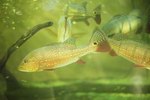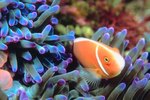
Problems with nitrogen compounds can decimate an aquarium. Specifically, elevated ammonia, nitrite and nitrate levels can wipe out most species of fish and ornamental invertebrates. Understanding and controlling nitrogen compounds make the difference between a successful aquarium and leaving the hobby in frustration.
The Nitrogen Cycle
The nitrogen cycle -- also called the ammonia cycle -- makes it possible to keep live fish in a glass box for more than a few days. All fish produce ammonia as a byproduct of their metabolism. Bacteria in an aquarium break this ammonia down into less toxic nitrite. Then, a second suite of bacteria break the nitrite down into nitrate, which has little effect on fish. In order for this process to work, you have to add a few fish to your aquarium at a time, then monitor ammonia and nitrite levels. Once these levels hit zero, perform a 25 percent water change and repeat with the next batch of fish until your tank is at capacity.
Ammonia
Ammonia is the first nitrogen product you need to test for in your aquarium. Test kits give ammonia readings in parts per million, written ppm. The only safe level of ammonia is 0 ppm. If you can detect ammonia, there is too much of it in the aquarium. Ammonia burns tissue, particularly a fish's gills. Symptoms of ammonia poisoning include gasping, breathing heavy and darting motions. Serious cases result in lethargic movement. Ammonia can enter a tank as fish waster, or from rotting food or decaying organic matter like dead fish. The only rapid, short-term way to control ammonia is through water changes. In the long term, the nitrogen cycle will break it down.
Nitrite
Nitrite and ammonia have an inverse relationship. This means that when ammonia levels fall as a tank cycles, the nitrite levels rise as bacteria convert the ammonia to nitrite. Nitrite is less toxic than ammonia but still dangerous for fish. Again, 0 ppm should be your goal. The symptoms of nitrite poisoning mimic those of ammonia poisoning. The treatment is also the same. If you see fish gasping or darting around the tank, you need to perform a water change to keep them alive until nitrogen metabolizing bacteria can catch up with the nitrogen levels.
Nitrate
Nitrate is the least toxic of these three compounds. It is typically removed through water changes, though in salt water aquariums the biological filtration process tends to metabolize it the same way ammonia and nitrite are broken down. While less toxic, you should still keep an eye on nitrate levels, particularly on tanks that have been running a while. generally, you want to make certain that nitrate levels do not rise above 40 ppm.
References
Photo Credits
-
Medioimages/Photodisc/Valueline/Getty Images




